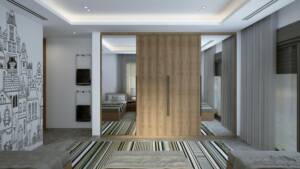
A wood accent wall can transform a space, adding warmth and texture to any room. It acts as a focal point, drawing the eye and instilling a sense of nature indoors. Many homeowners and designers are increasingly turning to this trend as it offers versatility in style and design.
Choosing the right type of wood and style can enhance a room’s aesthetic without overwhelming it. From shiplap to reclaimed wood, the options available cater to various preferences and budgets. Incorporating a wood accent wall not only beautifies a space but can also increase the home’s value.
The installation process can be straightforward for many DIY enthusiasts, making it an appealing project. With the proper tools and materials, anyone can achieve a professional look. This makes a wood accent wall an accessible way to refresh a home’s interior design.
Benefits of Adding a Wood Accent Wall
Introducing a wood accent wall enhances both the aesthetic value and functionality of a space. This feature promotes warmth, versatility, and can even increase property values.
Aesthetic Appeal and Warmth
A wood accent wall adds significant aesthetic appeal. The natural grain and texture of wood create a feeling of warmth that softens a room’s ambiance. Various types of wood, such as oak, pine, or cedar, offer different colors and patterns, allowing for customization.
Incorporating a wood wall can break up the monotony of flat surfaces. It introduces visual interest, drawing the eye and becoming a focal point. Paint or wallpaper may lack this organic quality, while wood complements various decor styles, from rustic to modern.
Versatility in Design
Wood accent walls adapt to diverse interior styles. This versatility means they can seamlessly blend into any environment, whether in a cozy cabin or a contemporary urban setting.
They can be applied in various ways, such as horizontal or vertical planks, shiplap, or reclaimed wood. These different applications allow homeowners to express their personal style.
Additionally, accent walls can frame artwork or televisions, enhancing the overall design.
Increases Property Value
Adding a wood accent wall can positively influence a property’s market value. Homebuyers often favor homes with unique, stylish features.
A well-executed wood wall can be seen as an upgrade, making a home more appealing. In some cases, it may attract higher bids during sales.
Investing in quality materials ensures durability, which buyers appreciate. When properly maintained, wood can last for years, making it a worthwhile investment.
Design Considerations and Installation
Selecting the right materials and installation techniques is crucial for achieving a successful wood accent wall. Careful attention to detail can enhance the wall’s aesthetic while ensuring durability.
Choosing the Right Wood and Finish
Deciding on the type of wood is essential for both aesthetics and functionality. Common choices include pine, cedar, and walnut. Each type offers distinct grain patterns and colors.
- Pine: Lightweight and budget-friendly. Good for a rustic look.
- Cedar: Naturally resistant to moisture and insects, ideal for damp environments.
- Walnut: Offers a rich color and elegance but is pricier.
Finishes range from stains to paints. Stains highlight the wood grain and provide a natural look, while paints can add a modern touch. Using a protective sealant prolongs the life of the finish, making it resistant to wear and tear.
Wall Preparation and Material Handling
Proper wall preparation is vital for a successful installation. The wall surface should be clean, dry, and free of any imperfections.
- Inspect the Wall: Look for cracks, holes, or moisture issues.
- Clean the Surface: Dust and debris must be removed to ensure adherence.
- Level the Surface: A level surface will prevent warping of wood tiles.
Material handling requires care. Wood should be acclimated to the room’s temperature and humidity for several days before installation. This prevents expansion or contraction after the wall is completed, which could lead to gaps or damage.
Installation Techniques
Several techniques can be used to install a wood accent wall, each with unique benefits.
- Direct Stick Method: Applying adhesive directly to the wall. Best for lightweight materials.
- Nail or Screw Method: Using nails or screws to secure wood planks to the wall studs. Provides strong durability.
- Paneling System: Pre-cut panels for easy installation. Ideal for beginners.
It is essential to stagger joints for a natural look and secure all planks properly to the wall. Utilizing a level during installation ensures that the rows remain even for a professional finish.
Gold Belt Buckle: A Timeless Accessory for Every Occasion
The gold belt buckle has long been a symbol of status, craftsmanship, and personal style. …









